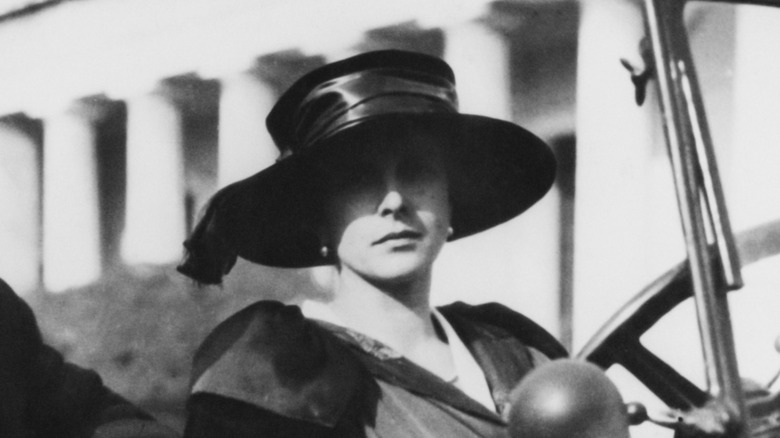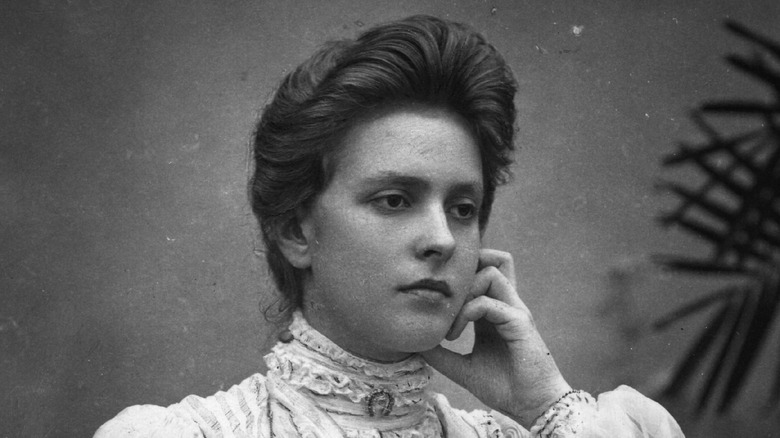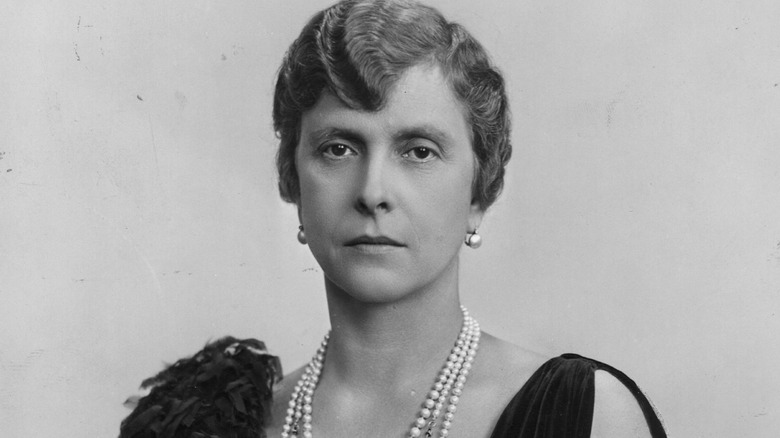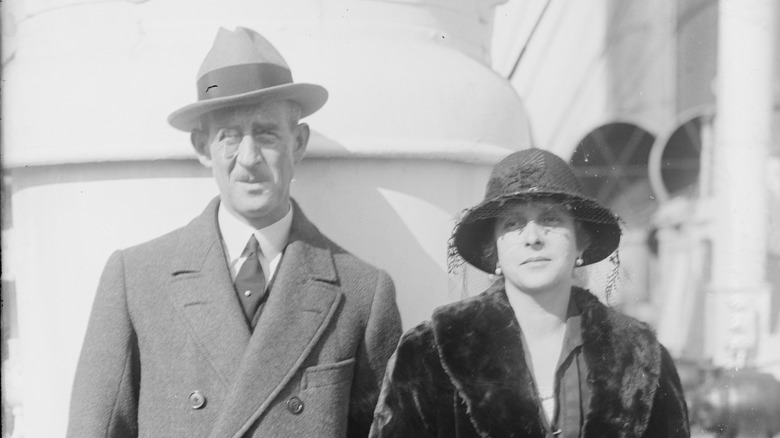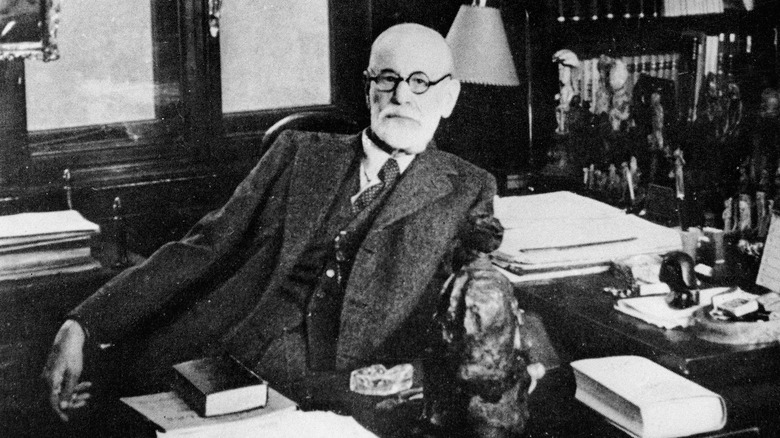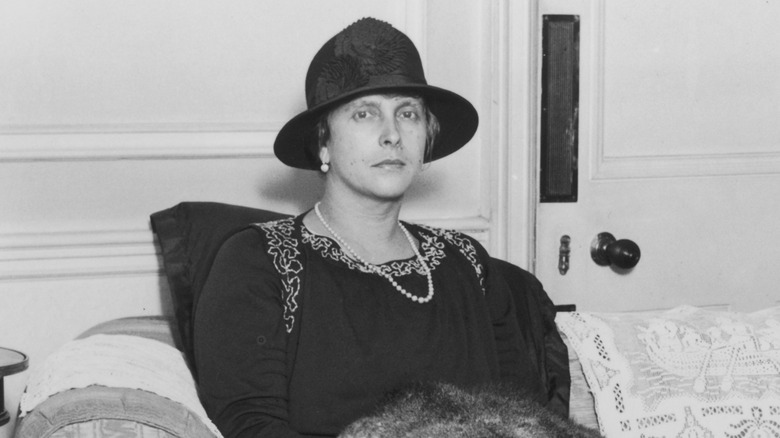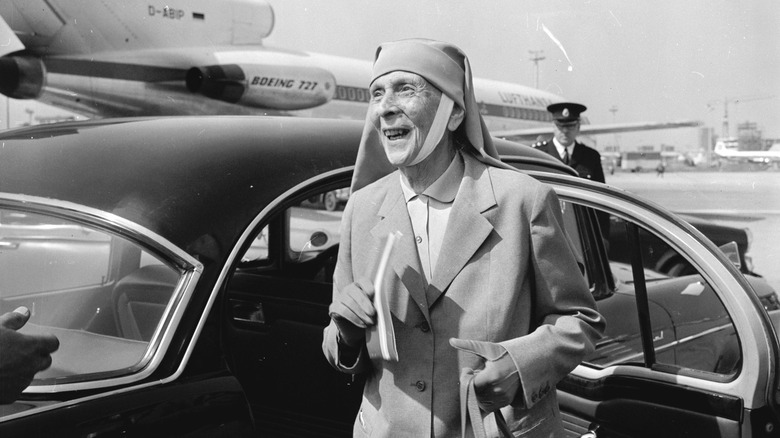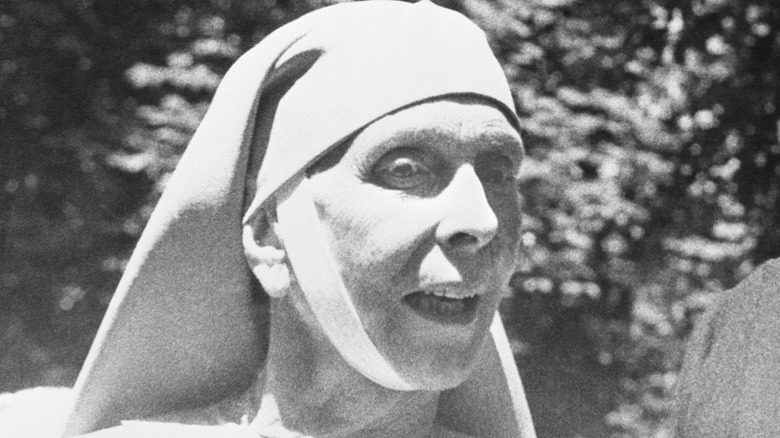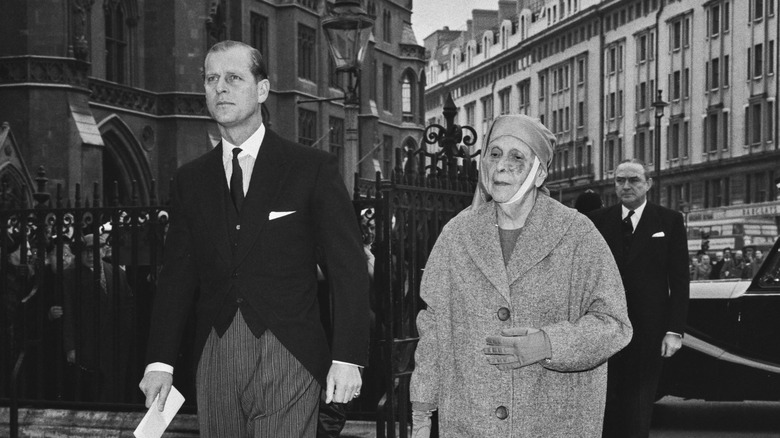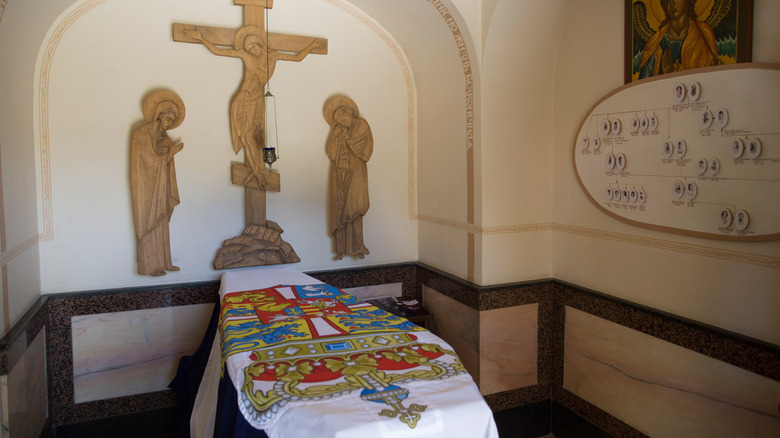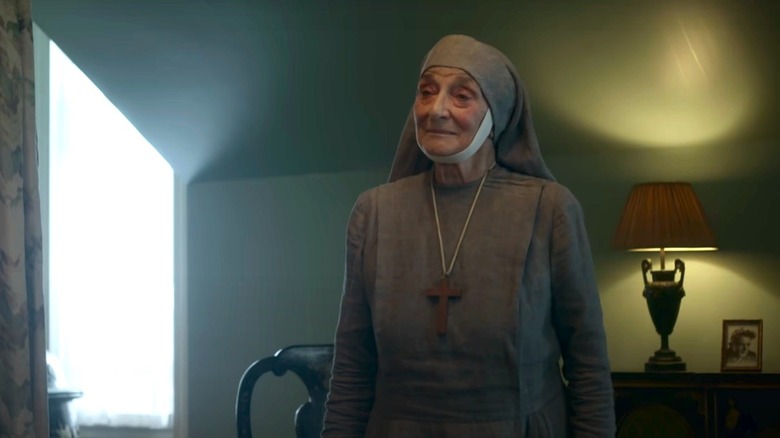The Tragic Life Of Prince Philip's Mother, Princess Alice
Britain's royal family has been the subject of media scrutiny since there has been media, and public fascination with the House of Windsor remains unabated. Truth be told, much of that scrutiny has been brought about by the royals themselves, from the slow-motion train wreck that was the marriage of Charles and Diana, to Prince Andrew's unfortunate friendship with Jeffrey Epstein, to Prince Harry's scorched-earth, tell-all memoir "Spare." Yet when it comes sheer Shakespearean-level tragedy, it's difficult to top the sad life of Princess Alice of Battenberg, mother of Prince Philip. Born into the lap of luxury in 1885 — drawing her first breath in no less a locale than Windsor Castle — Princess Alice was the great-granddaughter of Queen Victoria, who was reportedly present at Alice's birth. She was also born deaf, a condition that had to be hidden; she covered by learning to read lips, and became fluent in several languages.
Wed to Prince Andrew of Greece and Denmark, Alice bore five children. Despite her royal lineage, Alice's life was far from easy, enduring marital difficulties, mental health issues, and the death of her daughter, in addition to being displaced and exiled during the course of two world wars — in which some members of her family fought for the Germans, and others fought against them.
To learn more about this fascinating and misunderstood royal, read on for a look at the tragic life of Prince Philip's mother, Princess Alice.
World events made her life turbulent and unsettled
As Hugo Vickers wrote in his historical biography "Alice: Princess Andrew of Greece," digging up information on Princess Alice was no mean feat given her penchant for privacy. In fact, he noted, she habitually destroyed all her correspondence after reading it. "She was a very private person," Vickers told The Times. "She didn't give interviews. She was so reserved that she destroyed all her letters and, when she died, she only left three dresses."
One thing about her life that has been well established, however, is how unsettled it was. "In the course of her life, virtually every point of stability was overthrown," Vickers wrote. That instability began in 1903, when the 18-year-old princess married Prince Andrew of Greece and Denmark, moving to Greece in order to live with her new husband and royal in-laws. The next few decades, however, proved to be tumultuous ones for royalty throughout Europe, and Prince Andrew was not spared. At the time of her wedding, the three power centers of Europe were ruled by three first cousins, all of whom she was related to: King George V of Britain, Kaiser Wilhelm II of Germany, and Tsar Nicholas II of Russia.
After World War I, only George remained enthroned, as the royal houses of Europe fell like dominos — a situation that would yield major repercussions in her future.
She was exiled from Greece
In 1917, in the midst of the First World War, Princess Alice and her husband Prince Andrew were exiled from Greece, forced to flee to Switzerland. They weren't alone; all their fellow Greek royals were likewise sent packing, after King Constantine I was forced to abdicate when the pro-German monarch's desire to retain a Switzerland-like neutrality clashed with the Greek prime minister's aim of joining the anti-German forces.
After the war, in 1920, Constantine returned — but not for long. In 1922, the Greek army decisively lost its war against Turkey, culminating in 1.2 million Greek refugees forced to flee in what came to be known as the Asia Minor Catastrophe. Constantine and the other Greek royals were forced out, this time for good. At that point, wrote Hugh Vickers in his book about Princess Alice, Prince Andrew was serving in a military leadership role in Greece and accused of negligence, and punished by being "degraded and condemned to perpetual banishment." As a result, Alice was once again thrust into exile, living the life of an aristocratic nomad without a place to truly call home.
Decades later, Princess Alice was exiled from Greece for a third time during the Greek junta of 1967. In her 80s and physically frail, Alice wound up on the doorstep of Buckingham Palace, home to her son, Prince Philip, and his wife Queen Elizabeth II.
She was diagnosed with schizophrenia and sent to a sanitarium
In 1930, Princess Alice experienced what's been described as a "religious crisis." As Hugo Vickers wrote in his book, she began having religious visions, alienating her family and making strange proclamations about meeting Christ and the Buddha.
According to the British Psychological Society, as her behavior grew increasingly erratic and her physical condition deteriorated, her concerned family eventually called in a psychiatrist who specialized in treating soldiers suffering from PTSD, then referred to as shell shock. Also consulted was Sir Maurice Craig, who treated future king George VI to help with his stuttering. Both came to the identical conclusion, diagnosing schizophrenia. She was sent, involuntarily, to the Tegel Clinic in Berlin, where she was treated by the clinic's founder, Ernst Simmel.
Unhappy to be there and unwilling to submit to Simmel's treatment, Princess Alice made little progress and her condition worsened. Feeling he'd run out of options, Simmel transferred Alice to an asylum at Kreuzlingen which was run by Ludwig Binswanger. Binswanger likewise confirmed the previous diagnosis of schizophrenia — and was equally as unsuccessful at treating her. Both Binswanger and Simmel were acolytes of Sigmund Freud, and eventually decided to consult with the trailblazing father of psychoanalysis in hopes of figuring out an appropriate treatment.
If you or someone you know needs help with mental health, please contact the Crisis Text Line by texting HOME to 741741, call the National Alliance on Mental Illness helpline at 1-800-950-NAMI (6264), or visit the National Institute of Mental Health website.
Princess Alice endured brutal treatment from Sigmund Freud
Once he was made aware of the specifics of Princess Alice's religion-fuelled delusions, Sigmund Freud offered another diagnosis. According to Freud, the princess's troubling visions were brought about by the "sexual frustration" she was experiencing due to a raging libido from elevated hormone levels. Freud ordered a course of treatment that, in hindsight, appears more barbaric than therapeutic: blasting Alice's ovaries with X-rays, with the aim of destroying her libido by attempting to accelerate the process of menopause.
Princess Alice protested, insisting she was sane. She repeatedly attempted to flee the asylum, but to no avail. Princess Alice eventually underwent the X-ray treatment, which ultimately proved to be a failure. The radiation from the X-rays, however, did have an unanticipated impact, leaving her with health problems that plagued her for the rest of her life. During her years in the asylum, Alice was also given electroshock treatment, ostensibly to deal with what doctors characterized as hysteria (via the Evening Standard).
It wasn't until the mid-1930s that Alice was finally allowed to leave the asylum, after spending two years institutionalized. By this point, she was in her mid-40s, and was allowed to return to Greece. She wouldn't reunite with her husband, Prince Andrew, until 1937, however; that reunion was under tragic circumstances, taking place at the funeral of their daughter, Cecilie, who perished alongside her husband and two children in an airplane accident.
She sheltered a Jewish family during the Nazi occupation of Greece
In 1941, during the Second World War, Princess Alice was living in Athens when the Nazis invaded and took over the country. It was during the Nazi occupation that Alice took it upon herself to shelter a family of Jews, the Cohens, in her home, realizing that she was the only thing standing in the way of the family being sent to a concentration camp. According to the Telegraph, Alice used her deafness as an excuse to refuse Gestapo officers entry to her home, pretending she could neither read lips nor speak German — even though she could easily do both.
"What Princess Alice did, she saved the whole family," Evy Cohen — whose grandmother, aunt and uncle hid in Alice's Athens home — told The Guardian. "Clearly I wouldn't be alive, I wouldn't be here, I wouldn't be born if it hadn't been for her."
Following Alice's death, she was honored by the Yad Vashem Holocaust Museum in Jerusalem, presented posthumously with the "Righteous Among the Nations" award. In 1994, Prince Philip visited Jerusalem to attend a ceremony honoring his mother. "I suspect that it never occurred to her that her action was in any way special," Philip said at the time. "She would have considered it to be a perfectly natural human reaction to fellow beings in distress."
She tried to overcome tragedy through religion
During World War II, Princess Alice found herself in a particularly unique position. Her son, Prince Philip, was fighting against the Nazis while serving in the Royal Navy. Meanwhile, the husbands of two of her daughters were German, and were both proud Nazis. Alice's own leanings, however, were defiantly anti-Nazi. According to the Greek Reporter, she was once approached by a German general, who admired that she had two sons-in-law fighting against the Allies. After he asked what he could do to assist her, she reportedly responded, "You can take your troops out of my country."
After all she had been through — exile, estrangement from her family, undergoing brutal treatment in an asylum — Alice found solace in religion and charity work, helping out at soup kitchens and assisting the Red Cross. When the war ended, she felt she'd found her calling and founded her own religious order, the Christian Sisterhood of Martha and Mary, and established a convent in Athens under the auspices of the Greek Orthodox Church.
She spent the next two decades seeking funding for the convent, which was devoted to helping the poor and indigent in Athens with medical care, and also housed a school to train nuns. For the remainder of her life, Alice wore a nun's habit and devoted herself to philanthropy.
She gave away all her worldly possessions
While Princess Alice may have been born with the proverbial silver spoon in her mouth, her lifestyle became radically different after she founded her convent. With immense royal wealth at her disposal, during her years in Athens while living as a nun, she lived in poverty.
According to reports, she died penniless and with few possessions; what she hadn't given away to those less fortunate, she sold in order to fund her convent.
To what degree her decision to give away everything she owned stemmed from her struggles with mental illness is a matter of speculation. What isn't, however, is that when she left Greece to live with her son in Buckingham Palace, she arrived with nothing but clothing and a few personal effects. She spent the next two years living quietly, out of the spotlight, in a suite in the palace. It was during those years that she was reportedly able to reconcile with her son, with whom she'd always had a complicated and disconnected relationship.
Her relationship with her son Prince Philip was a distant one
Prince Philip and mother Princess Alice did not have a particularly close relationship. In fact, due to her undiagnosed schizophrenia, and subsequent commitment to an asylum for treatment — and the fact that Philip was sent to boarding school in England — Alice missed out on much of her son's childhood. Philip's uncle, Lord Mountbatten, picked up the slack, serving as parental figure to the young prince.
Even though they weren't close, that didn't meant that Alice was excluded from the milestones in her son's life. She was on hand at Westminster Abbey to attend his wedding to then-Princess Elizabeth, and was also an invited guest at her coronation.
She paid her son and daughter-in-law a visit in 1965, where she attempted to get reconnect with her son and get to know her grandchildren. According to Radio Times, it was during this time that she concocted a sweet nickname for the Duke of Edinburgh, "Bubby-kins," and took to playfully referring to him and Elizabeth as a couple as "the Filibets." In a letter she wrote after her visit, she told Philip, "You do not know how happy you have made me this summer & I am so sad it was over so quickly."
Her final wish wasn't granted until years after her death
Princess Alice of Battenberg died in 1969 while living in Buckingham Palace. She was 84 years old. Her dying wish was to be buried in Jerusalem, next to her cousin, Russian Grand Dutchess Elizabeth Feodorovna. Elizabeth was among the members of Russian royalty assassinated by Bolsheviks in the midst of the 1917 Russian Revolution; after her body was discovered in a Siberian salt mine, the remains were taken to Jerusalem and buried there, at which point she was declared a saint.
Sadly, Alice's request was not honored — at least, not immediately. As UPI reported, she was instead buried at St. George's Chapel in Windsor. There were some complicating factors behind the denial of her request, including fallout from the Middle East War in 1967, and the fact that her religions was Greek Orthodox while her cousin was Russian Orthodox — as was the church in which she'd asked to be buried.
In 1988, nearly 20 years after her death, Princess Alice's remains were exhumed and brought to Jerusalem for reburial in her final resting place: in the White Russian convent of St. Mary Magdalene in Gethsemanie, next to her cousin. Due to diplomatic concerns, Prince Philip was unable to visit his mother's grave until 1994. Prince William subsequently followed suit, visiting his great-grandmother's gravesite in 2018.
Princess Alice's tragic life was dramatized for The Crown
Throughout her life and certainly since her death, Princess Alice has been a somewhat obscure and mystery-shrouded figure in the annals of British royalty. However, that changed in 2019, when Netflix drama "The Crown" focused an entire episode on the story of Princess Alice.
However, like many of the historical events depicted in "The Crown," not everything about Alice that was dramatized for the series was actually true. In the episode, Princess Alice (portrayed in the series by actor Jane Lapotaire) is introduced attired in a nun's habit, smoking a cigarette, as she attempts to sell a sizeable diamond brooch to a jeweller in Athens; he assumes the item is stolen, and calls the cops. That's when the authorities — and, by extension, viewers — discover that this impoverished, chain-smoking nun is actually the mother of Prince Philip. According to Robert Lacey, historical adviser to "The Crown" (via Elle), that scene may have led to a dramatic introduction, but it didn't actually happen.
